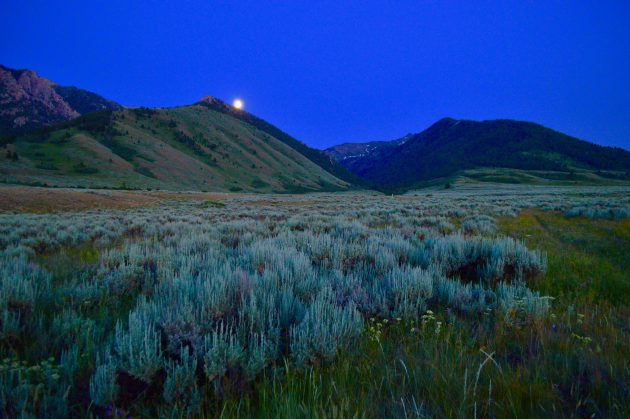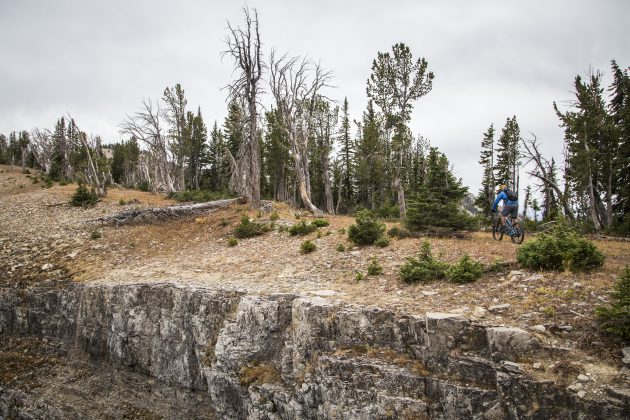Hear Us Roar: Lionhead, Montana
Originally posted on April 26, 2019 at 0:01 am by David TuckerIn Montana, mountain bike advocates seek continued access to the Lionhead
by David Tucker
Halfway up the final climb to Targhee Pass, our progress grinds to a halt. From the high side of the trail, a ball of earth the size of a VW bus hovers suspended in midair, propped up by six 50-foot beams of timber. This is the biggest obstacle we’ve faced all day, 15 miles into our 20-mile ride on the Continental Divide Trail (CDT) along the Idaho-Montana border. This area is lovingly referred to as the Lionhead, and it might offer the best high-alpine riding still available anywhere in the United States.
Our leader, Justin, lets out a deep, audible sigh, then dismounts his fat-tired steed, assessing the situation as he pulls on chaps and un-sheaths his chainsaw. So far, the riding has been spectacular, but we’re here to work. Along with dozens of other volunteers, we’ve come to this section of the CDT west of West Yellowstone, Montana to remove downed trees, drain any standing water, and generally assess the conditions on the ground. Volunteers from the Southwest Montana Mountain Bike Association and members of the Gallatin Valley Backcountry Horsemen have made this an annual tradition for over a decade, partnering with the Forest Service in a show of trail-user collaboration.
After walking around the pile of debris for several minutes, sawyer Justin ushers me and the other volunteers into safe positions before starting to cut. One incision at a time, he breaks down the bundle into manageable pieces that we carry off the trail. Now the way is passable — not only for the 20 or so riders behind us, but for the scores of through-hikers, trail runners, horse-packers and hunters that will use this trail for the rest of the season and many more to come.
That is, unless the Custer Gallatin National Forest (CGNF) decides to manage these trails as Wilderness, effectively banning many of the devoted stewards who have come to cherish the Lionhead-area trails — the mountain bikers.
Currently, cyclists are allowed in the Lionhead, much of which lies within a Recommended Wilderness Area. Roughly half the trails sit on the Idaho side of the border, and half on the Montana side. Region 4 of the Forest Service manages the Idaho-side trails, allowing continued bike use. The Montana-side trails are managed by Region 1, often a more restrictive region that has been taking steps to ban cyclists from trails in Recommended Wilderness and Wilderness Study Areas, even if cyclists have traditionally enjoyed those trails — and, as in the case of the Lionhead, been the trails’ primary stewards. These closures have happened without demonstrable social or resource impacts.
While previous proposals to ban cyclists from the Lionhead have not been adopted, access is still tenuous. As the CGNF undergoes its Forest Plan Revision, a policy that will govern forest management for the next few decades, trail access is once again under threat. In March, the CGNF released a series of management alternatives for public comment. Two options retain bike access but are less likely to be adopted. Three of the more-likely alternatives make the retained-bike-access path forward unclear or downright impassable.
The bottom line is, advocates for Congressionally-designated Wilderness oppose bike access to the Lionhead, and that’s hard to stomach. Mountain bikers recognize the Lionhead’s highly wild and unaltered nature—for many, wildness is the area’s appeal. The climbs are hard but the views are amazing. From Targhee Pass at over 10,00 feet, you can look south and see the Tetons, east into Yellowstone, north to the Taylor-Hilgard mountains, and west to the foreboding summit of Targhee Peak. The chances of running into a toothy apex predator are relatively high, and mountain goat clans make the adjacent cliff bands their homes. Elk sign is plentiful and people are few. Cyclists actively support maintaining the area’s wild character, so losing access is downright heartbreaking — all the more so because of the countless hours they’ve dedicated to the trails alongside their equine partners.
In light of this access threat, regional mountain bikers have been pushing for what they feel is an underutilized management alternative—a designated Backcountry Area. This official designation would allow for a high level of natural resource conservation, while simultaneously permitting continued bike access. As mentioned, cyclists hold the area’s natural preservation in the highest regard, and this management option would guarantee that Lionhead retained its wild quality and all of its devoted conservation stewards, while allowing continued bike access.
At a time when agency recreation budgets are plummeting, when maintenance backlogs grow mile by mile, year after year, when the politics of division rule coast to coast, the Lionhead can be a shining example of what can happen when the spotlight is on common interests and not petty differences. Montana mountain bikers continue to see backcountry access evaporate one Forest Plan Revision after another, but together our individual voices can grow into an appeal for logical, proactive management, instead of blanket bans.
In the coming weeks, we have a chance to make a difference. We can let the Forest Service know how much the Lionhead means to us by writing a letter in support of continued bike access. For more information about the history of land management and bike access to the Lionhead area, visit mtbcgnf.org.